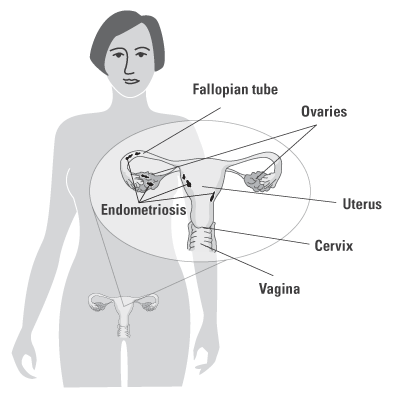Endometriosis: Everything you need to know!
Published Mar 6, 2021 • By Candice Salomé
Endometriosis is a common gynecological condition that affects almost one in ten women. Endometriosis can be asymptomatic, but it can also cause occasional or chronic gynecological pain, or even lead to infertility.
What do we know about endometriosis? What are its symptoms? How is it diagnosed? What solutions are there?
We tell you everything in our article!

What is endometriosis?
Endometriosis is a gynecological condition characterized by the abnormal presence of endometrial tissue (or uterine tissue) outside the uterine cavity. This tissue follows the hormonal cycle as if it were in the uterine cavity when it is in fact in the abdominal cavity. At the end of the monthly cycle, endometriosis lesions become congested and bleed during menstruation. However, unlike menstruation, which is evacuated from the body, the blood from the "errant" tissue has no way out. The tissue surrounding these lesions is therefore swollen and painful, irritated by the bleeding.

Source: Office on Women's Health, U.S. Department of Health & Human Services
Endometriosis is a complex condition because it does not develop in the same way from one woman to another.
There are 4 main types of endometriosis, which can be defined as follows:
- Superficial peritoneal endometriosis: In this type, the endometrial tissue attaches to the peritoneum, is the thin membrane which lines the abdomen and pelvis, covering most of the organs in the two cavities. This is the least severe form of endometriosis.
- Endometrioma: Endometriomas are cysts characterized by their chocolate-colored fluid content. They are sometimes referred to as "chocolate cysts". They appear in various sizes and can form in different parts of the abdomen or pelvis, but are most commonly found on the ovaries.
- Abdominal wall endometriosis: This refers to endometrial tissue that grows on the abdominal walls, often attaching to surgical scars, such as one from a C-section.
- Deep infiltrating endometriosis (DIE): In this type of endometriosis, the endometrial tissue invades the organs within or outside the pelvic cavity, including the ovaries, bladder, intestines and rectum. In rare cases (in only 1-5% of endometriosis patients), tissue can fuse to organs so they become stuck in place, a condition called frozen pelvis.
No correlation has been found, however, between the type of endometriosis and the intensity of pain. For example, superficial peritoneal endometriosis, though technically the least severe form, can be very painful due to the presence of many nerves in the peritoneum.
Endometriosis is a chronic condition that develops during the reproductive period of a woman's life. Thus, with each menstrual cycle, the lesions proliferate, bleed and leave fibrous scars.
What are the symptoms of endometriosis?
The symptom evoked in 50 to 91% of cases is pain. This pain can manifest in different ways:
- Pain during menstruation (dysmenorrhea)
- Pain during sexual intercourse (dyspareunia)
- Frequent pelvic pain
- Pain during bowel movements
- Pain during urination
- Abdominal pain and discomfort, such as bloating
- Lower back pain
This pain is often cyclical and does not pass after taking analgesics (painkillers). It can be sporadic or chronic, and can sometimes be very intense. As it is linked to the reproductive cycle, pain is generally more intense at the time of ovulation or menstruation.
Carenity members living with endometriosis describe their pain and symptoms as follows:
"My symptoms are the following: digestive disorder, headaches and repetitive migraines, stomach aches, period pain and pain during intercourse, trouble with bowel movements, bloating depending on what I eat..."
- @Fleur30
"I have DIE and was operated on twice - once in January 2017 and another time in September 2017. I have pain when I urinate, pain during sexual intercourse, general abdominal pain, blood in my urine, chronic fatigue and pain in my legs and my back."
- @nesse25
"I have had abdominal pain during my period ever since I started having it, but I also have it when I'm not on my period... I've had an IUD since November, which has stopped my period. I had to change because when I was on the pill I still had my period, which triggered UTIs, fungal infections, vaginal cuts and of course pain during sex. For the last two and a half years I've also had digestive issues, frequent nausea and vomiting, bowel transit problems, migraines and dizziness."
- @Morgane888
How is endometriosis diagnosed?
As endometriosis is often diagnosed late, 8 to 10 years can go by between the first symptoms and official diagnosis.
To diagnose, the GP will evaluate the extent and nature of the painful symptoms. If necessary, he or she can refer the patient to a specialist in gynecology or obstetrics. The specialist can then prescribe additional tests such as:
- Abdominal and pelvic ultrasound - to see the endometriosis lesions.
- MRI - this can also be prescribed in follow-up to look for possible lesions on the peritoneum or internal organs and to determine their number and location before surgical treatment.
- When the endometriosis is suspected to have reached the colon, a virtual colonoscopy can be prescribed to help make a detailed record of any lesions in the digestive tract.
- More rarely, laparoscopy may be considered. It enables exploration of the pelvic and abdominal cavity and makes it possible to identify endometriosis lesions (number, location) and places where scar tissue may have attached.
Endometriosis is often diagnosed during the course of infertility examinations. In fact, 30 to 40% of women with endometriosis face infertility issues.
How is endometriosis treated?
To date, there is no definitive treatment for endometriosis, but hormone therapy or surgery can limit its progression for several years, depending on the case.
However, treatment is only recommended when endometriosis affects daily life or the functioning of an organ.
Drug treatments
In order to reduce hormone-dependent endometriosis lesions (which develop during menstruation), the doctor may prescribe treatments that stop menstruation (oral contraception or IUDs). These treatments reduce or eliminate pain and lesions regress.
To alleviate the pain associated with endometriosis, the doctor may prescribe non-steroidal anti-inflammatory drugs (NSAIDs).
Alternative therapies can be used to improve quality of life and combat pain, such as:
- Acupuncture
- Physiotherapy
- Yoga
- Hypnosis
Surgical intervention
Depending on the case, surgery may be necessary to remove endometriosis lesions.
It is recommended in the following cases:
- When endometriosis is painful endometriosis and/or in case of infertility with a desire to become pregnant, and depending on the organs affected, under the condition that the surgery will bring more benefits (pain reduction, improvement of fertility) than harm (urinary incontinence).
- In case of endometriomas
Surgery first of all makes it possible to take stock of the extent and nature of the endometriosis lesions. It then makes it possible to destroy the lesions (by electrocoagulation or laser ablation) or to remove them (by excision).
Generally, surgery is carried out under laparoscopy, a technique that facilitates post-operative care and limits adhesions.
Was this article helpful to you?
Share your thoughts and questions with the community in the comments below!
Take care!
Sources:
- What is Endometriosis?, Endometriosis Foundation of America
- Endometriosis, Office on Women's Health, U.S. Department of Health & Human Services
- Endometriosis Treatment and Support, Endometriosis Foundation of America
- Endometriosis Types and Stages, WebMD
- Endométriose, Inserm
- Endométriose : définition et facteurs favorisants, Ameli.fr
- Prise en charge de l'endométriose, HAS
- Comment diagnostiquer l’endométriose ?, EndoFrance
- Endométriose : symptômes, diagnostic et évolution, Ameli.fr
Comments
You will also like

Endometriosis and digestive issues: Understanding causes and symptoms for better relief!
Oct 23, 2024

 Facebook
Facebook Twitter
Twitter
